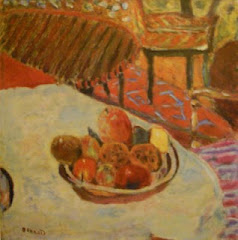The
first time-traveling I did, other than through smoked octopus and espresso, was
into the realm—along the footworn paths—of the Anasazis, an hour from Santa Fe
(and then eight hundred years or so).
"Yes, deep, narrow trails in white rock, worn by
their moccasin feet coming and going for generations.
And these old piñon trees have come up in the trail
since the race died off.
You can tell something about
how long ago it was by them."
—Willa Cather, The Professor's House
I
loved to walk at Bandelier, the canyon with the Anasazi ruins in its reddish
cliffs, the caves with wooden ladders climbing up to them, the remains of a
circular pueblo below—Tyuoni—like a labyrinth you walk in prayer or meditation,
or the labyrinth under the palace of Knossos on Crete which would lure me later. The cliff face was marked with the round holes
where roof supports had been, and, further up the trail, with petroglyphs. The foot of it was as often as not awash with
yellow sunflowers, a kind of mirage in the summer sun.
That village sat looking down into the canyon with
the calmness of eternity.
The falling snow-flakes,
sprinkling the piñons, gave it a special kind of
solemnity. I can't
describe it. It was more like
sculpture than anything else. I knew at once that I
had come upon the city of some extinct civilization,
hidden away in this inaccessible mesa for centuries,
preserved in the dry air and almost perpetual sunlight
like a fly in amber, guarded by the cliffs and the river
and the desert.
—Willa Cather, The
Professor's House
In
high school or college I first read Willa Cather, and felt the wonder of the
discovery of Mesa Verde in the middle section of The Professor's House as keenly as the wonder I had always felt to
see our own much lesser cliff dwellings.
In The Song of the Lark her
character Thea is restored to herself by staying in an ancient cliff dwelling
in a canyon in Arizona, which is the most alluring—and comforting—thought.
From the ancient dwelling there came always a
dignified, unobtrusive sadness; now stronger, now
fainter,—like the aromatic smell which the dwarf
cedars gave out in the sun,—but always present,
a part of the air one breathed. At night, when
Thea dreamed about the canyon,—or in the early
morning when she hurried toward it, anticipating it,
—her conception of it was of yellow rocks baking
in sunlight, the swallows, the cedar smell, and that
peculiar sadness—a voice out of the past, not very
loud, that went on saying a few simple things to
the solitude eternally.
—Willa Cather, The
Song of the Lark
Later,
when I was back from college back from life beyond and went exploring on my own,
I discovered to my further wonder that Bandelier didn't just vanish in the
winter, close up and hunker down to hibernate. We simply never ventured out beyond the city
limits after September; travels and places were somehow precisely compartmentalized.
(And when I drove to Taos one day and
found out just how wonderful it is, I was indignant to have been without it all
my life, and asked my mother, disbelieving, why we had never gone there, to be
told "I've never liked Taos much."
Perhaps this all explains my lifelong need to test boundaries and break
out of compartments?) With snow on the
ruins—can I possibly say like frosting on a cake?—the magic that was Bandelier
was more magical still, more strange. My
being there felt like the the unobtainable almost obtained.
Maybe
because of that, my favorite journey on the afternoon of New Year's Eve came to
be to Tsankawi, sister to Bandelier, "village between
two canyons at the clump of sharp, round cacti."
That liminal space between the old and new, what was to be and what was
spent. The place that seemed not to
exist, not in the off months, so was especially wonderful to visit then.
images: Christie B. Cochrell, Bandelier in Snow, Bandelier in Summer (photo of a photo, faded over the years), and Cliff Dwellings in Winter (photo of a photo again)

























